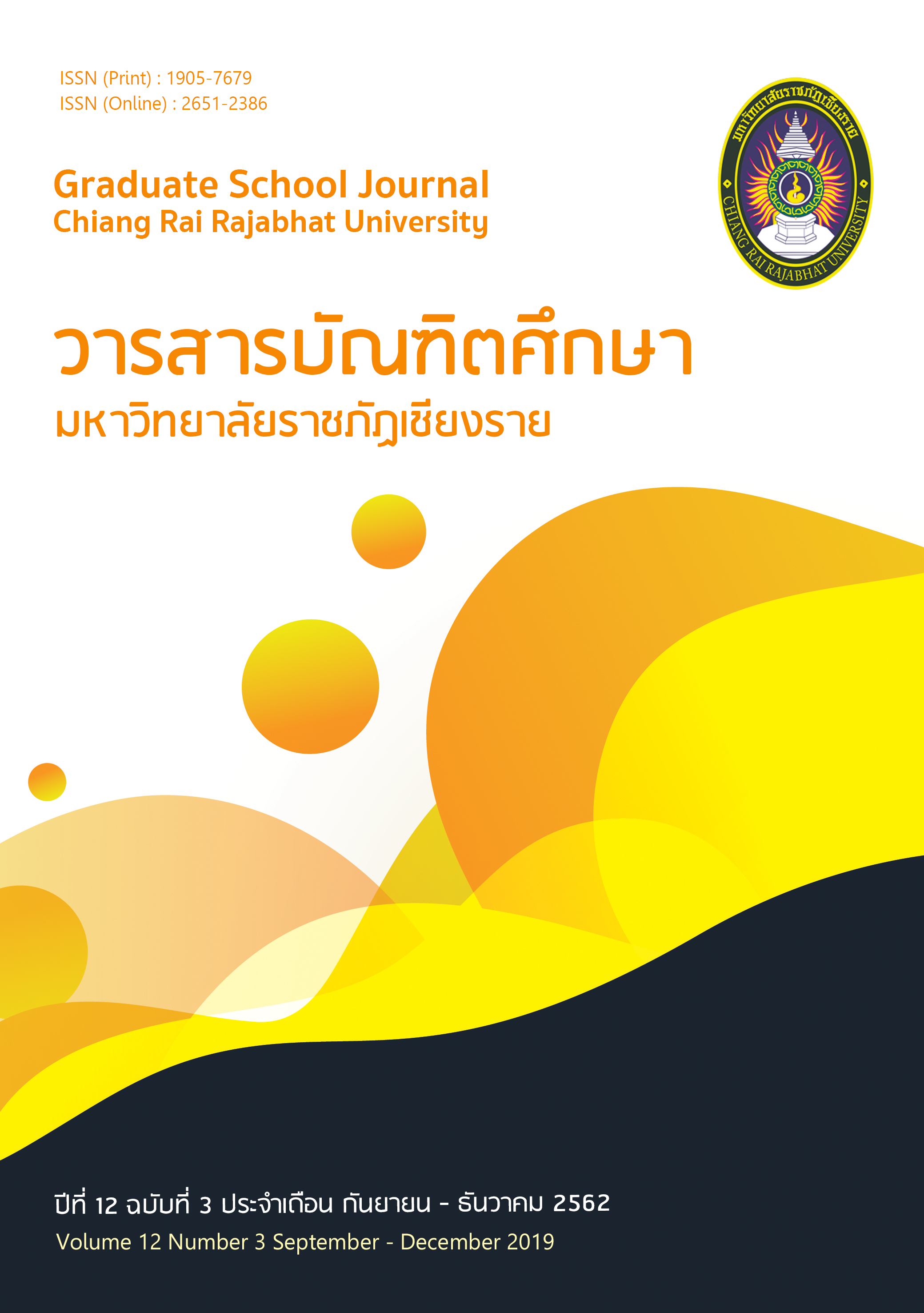แนวทางการพัฒนาการบริหารจัดการกระบวนการจัดการเรียนรู้ภาษาจีน สู่ความเป็นเลิศของโรงเรียนวัฒโนทัยพายัพ จังหวัดเชียงใหม่
Main Article Content
บทคัดย่อ
วิทยานิพนธ์ เรื่อง แนวทางการพัฒนาการบริหารจัดการกระบวนการจัดการเรียนรู้ภาษาจีนสู่ความเป็นเลิศของโรงเรียนวัฒโนทัยพายัพ จังหวัดเชียงใหม่ มีวัตถุประสงค์ 1) เพื่อศึกษาวิเคราะห์สภาพ ปัญหาการบริหารจัดการกระบวนการจัดการเรียนรู้ภาษาจีนของโรงเรียนวัฒโนทัยพายัพ จังหวัดเชียงใหม่ 2) เพื่อศึกษาการบริหารจัดการกระบวนการจัดการเรียนรู้ภาษาจีนของสถานศึกษาที่มีการปฏิบัติเป็นเลิศในจังหวัดภาคเหนือตอนบน 3) เพื่อจัดทำและตรวจสอบแนวทางการพัฒนาการบริหารจัดการกระบวนการจัดการเรียนรู้ภาษาจีนสู่ความเป็นเลิศของโรงเรียนวัฒโนทัยพายัพ จังหวัดเชียงใหม่ โดยประยุกต์ใช้กรอบแนวคิดและหลักการจัดการเรียนการสอนโดยเน้นผู้เรียนเป็นสำคัญ ใน 3 ด้าน คือ 1) ด้านการเตรียมการสอน 2) ด้านการจัดกิจกรรมการเรียนการสอน 3) ด้านการวัดและประเมินผล บูรณาการกับการบริหารจัดการเชิงระบบ คือ ปัจจัยนำเข้า กระบวนการ และผลผลิต กลุ่มผู้ให้ข้อมูลในการศึกษาสภาพ ปัญหา การบริหารจัดการกระบวนการจัดการเรียนรู้ภาษาจีนของโรงเรียนวัฒโนทัยพายัพ จังหวัดเชียงใหม่ ประกอบด้วยรองผู้อำนวยการกลุ่มงานวิชาการ หัวหน้ากลุ่มสาระฯ ภาษาต่างประเทศที่ 2 ตัวแทนครูผู้สอนวิชาภาษาจีน จำนวน 2 คน ตัวแทนนักเรียนแผนการเรียนภาษาจีน จำนวน 155 คน กลุ่มผู้ให้ข้อมูลในการศึกษาการบริหารจัดการกระบวนการจัดการเรียนรู้ภาษาจีนของสถานศึกษาที่มีการปฏิบัติเป็นเลิศในจังหวัดภาคเหนือตอนบน ประกอบด้วยผู้อำนวยการโรงเรียน รองผู้อำนวยการกลุ่มงานวิชาการ หัวหน้ากลุ่มงานภาษาจีน จำนวน 6 คน ตัวแทนครูผู้สอนวิชาภาษาจีน จำนวน 2 คน ตัวแทนนักเรียนแผนการเรียนภาษาจีนที่เป็นหัวหน้าห้อง จำนวน 9 คน กลุ่มผู้ให้ข้อมูลในการจัดทำและตรวจสอบแนวทางการพัฒนาการบริหารจัดการกระบวนการจัดการเรียนรู้ภาษาจีนสู่ความเป็นเลิศของโรงเรียนวัฒโนทัยพายัพ จังหวัดเชียงใหม่ ประกอบด้วยผู้เชี่ยวชาญด้านภาษาจีนจากหน่วยงานต่าง ๆ จำนวน 14 คน เครื่องมือในการศึกษาประกอบด้วย 1) แบบสัมภาษณ์แบบมีโครงสร้าง 2) แบบสอบถาม 3) ประเด็นการสนทนากลุ่ม (Focus Group) และแบบบันทึกการสนทนากลุ่ม 4) แบบตรวจสอบแนวทาง วิเคราะห์ข้อมูลโดยการจัดเป็นหมวดหมู่สรุปข้อค้นพบตามประเด็นการสัมภาษณ์ และนำเสนอข้อมูลเป็นความเรียง การคำนวณค่าเฉลี่ยและส่วนเบี่ยงเบนมาตรฐาน ผลการศึกษาสภาพ ปัญหา การบริหารจัดการกระบวนการจัดการเรียนรู้ภาษาจีนของโรงเรียนวัฒโนทัยพายัพ จังหวัดเชียงใหม่ และผลการศึกษาการบริหารจัดการกระบวนการจัดการเรียนรู้ภาษาจีนของสถานศึกษาที่มีการปฏิบัติเป็นเลิศในจังหวัดภาคเหนือตอนบน สรุปได้ว่า แนวทางการพัฒนาการบริหารจัดการที่สำคัญ คือ การจัดทำโครงการพัฒนาศักยภาพการจัดการเรียนการสอนสู่ความเป็นเลิศด้านภาษาจีน ประกอบด้วย 3 กิจกรรม คือ กิจกรรมที่ 1 การนิเทศติดตามและประเมินผลคุณภาพการเรียนการสอนภาษาจีน กิจกรรมที่ 2 ตะลุยเมืองจีนผ่าน HSK กิจกรรมที่ 3 วัฒโนฯ ยูทูปเบอร์ ซึ่งผลการตรวจสอบแนวทางการพัฒนาโดยรวมมีความเป็นไปได้ และมีความเหมาะสมในระดับมากที่สุด
Article Details
บทความที่ได้รับการตีพิมพ์เป็นลิขสิทธิ์ของวารสารมหาวิทยาลัยราชภัฎเชียงราย
ข้อความที่ปรากฏในบทความแต่ละเรื่องในวารสารวิชาการเล่มนี้เป็นความคิดเห็นส่วนตัวของผู้เขียนแต่ละท่านไม่เกี่ยวข้องกับมหาวิทยาลัยราชภัฎเชียงราย และคณาจารย์ท่านอื่นๆในมหาวิทยาลัยฯ แต่อย่างใด ความรับผิดชอบองค์ประกอบทั้งหมดของบทความแต่ละเรื่องเป็นของผู้เขียนแต่ละท่าน หากมีความผิดพลาดใดๆ ผู้เขียนแต่ละท่านจะรับผิดชอบบทความของตนเองแต่ผู้เดียว
เอกสารอ้างอิง
จารุกร จรดล. (2558). สภาพปัญหาและแนวทางการพัฒนาการจัดการเรียนการสอนวิชาภาษาจีนของโรงเรียนมัธยมศึกษา จังหวัดนนทบุรี สังกัดสำนักงานเขตพื้นที่การศึกษามัธยมศึกษา เขต 3. (วิทยานิพนธ์การศึกษามหาบัณฑิต). มหาวิทยาลัยบูรพา. ชลบุรี.
ธีระเกียรติ เจริญเศรษฐศิลป์. (2560). ค่ายอบรมครูภาษาจีน รุ่นที่ 1. สืบค้นเมื่อ 16 ตุลาคม 2560, จาก กระทรวงศึกษาธิการ: http://www.moe.go.th
ภูวกร ฉัตรบำรุงสุข. (2559). การวิจัยเพื่อพัฒนาระบบการจัดการเรียนการสอนภาษาจีนในประเทศไทยระดับมัธยมศึกษา. กรุงเทพฯ: สำนักงานเลขาธิการสภาการศึกษา กระทรวงศึกษาธิการ.
สำนักงานคณะกรรมการการอุดมศึกษา. สำนักยุทธศาสตร์อุดมศึกษาต่างประเทศ. (2553). ยุทธศาสตร์ส่งเสริมการเรียนการสอนภาษาจีนในประเทศไทย. กรุงเทพฯ: สำนักงานฯ.
อุทัยวรรณ เฉลิมชัย. (2550). การส่งเสริมการเรียนการสอนภาษาจีน. วารสารวิชาการ สำนักงานคณะกรรมการการศึกษาขั้นพื้นฐาน, 10(3), 7-11.


